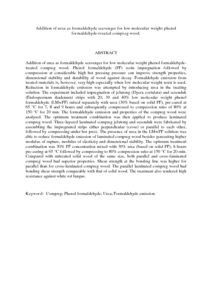Citation
M.A., Rabi'atol Adawiah and Ashaari, Zaidon and F.A., Nur Izreen and Bakar, Edi Suhaimi and Sahri, Mohd Hamami and Md. Tahir, Paridah
(2012)
Addition of urea as formaldehyde scavenger for low molecular weight phenol formaldehyde-treated compreg wood.
Journal of Tropical Science , 24 (3).
pp. 248-257.
ISSN 0128-1283
Abstract
Addition of urea as formaldehyde scavenger for low molecular weight phenol formaldehyde- treated compreg wood. Phenol formaldehyde (PF) resin impregnation followed by compression at considerable high hot pressing pressure can improve strength properties, dimensional stability and durability of wood against decay. Formaldehyde emission from treated materials is, however, very high especially when low molecular weight resin is used. Reduction in formaldehyde emission was attempted by introducing urea in the treating solution. The experiment included impregnation of jelutong (Dyera costulata) and sesenduk (Endospermum diadenum) strips with 20, 30 and 40% low molecular weight phenol formaldehyde (LMwPF) mixed separately with urea (30% based on solid PF), pre-cured at 65 °C for 7, 8 and 9 hours and subsequently compressed to compression ratio of 80% at 150 °C for 20 min. The formaldehyde emission and properties of the compreg wood were analysed. The optimum treatment combination was then applied to produce laminated compreg wood. Three-layered laminated compreg jelutong and sesenduk were fabricated by assembling the impregnated strips either perpendicular (cross) or parallel to each other, followed by compressing under hot press. The presence of urea in the LMwPF solution was able to reduce formaldehyde emission of laminated compreg wood besides generating higher modulus of rupture, modulus of elasticity and dimensional stability. The optimum treatment combination was 30% PF concentration mixed with 30% urea (based on solid PF), 8 hours pre-curing at 65 °C followed by compressing to 80% compression ratio at 150 °C for 20 min. Compared with untreated solid wood of the same size, both parallel and cross-laminated compreg wood had superior properties. Shear strength at the bonding line was higher for parallel than for cross-laminated compreg wood. The parallel laminated compreg wood had bonding shear strength comparable with that of solid wood. The treatment also rendered high resistance against white rot fungus.
Download File
![[img]](http://psasir.upm.edu.my/24009/1.hassmallThumbnailVersion/Addition%20of%20urea%20as%20formaldehyde%20scavenger%20for%20low%20molecular%20weight%20phenol%20formaldehyde.pdf)  Preview |
|
PDF (Abstract)
Addition of urea as formaldehyde scavenger for low molecular weight phenol formaldehyde.pdf
Download (84kB)
| Preview
|
|
Additional Metadata
Actions (login required)
 |
View Item |

